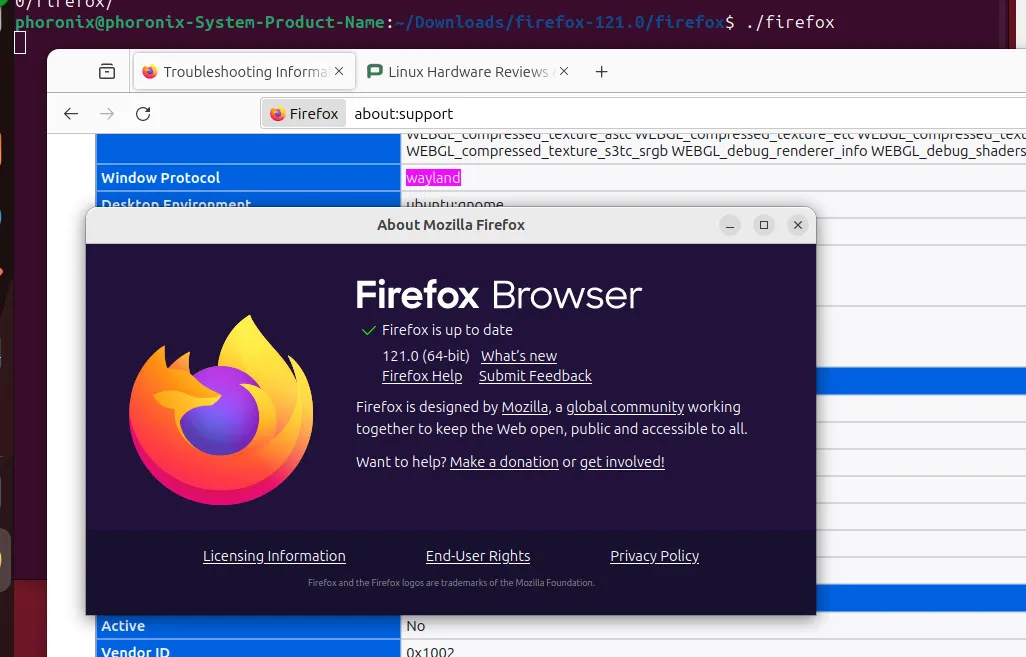I love Wayland because it simply tastes the best.
I am new to Linux. What’s the differences between Xorg and Wayland?
Both are display servers which is software that allows programs to write to the screen. X is older and was created back in 1984 at MIT and Wayland is a much newer protocol that is designed to work better on newer (post 90’s) hardware.
The biggest difference is that Wayland basicly allows your desktop direct access to the screen and X has a server that runs and allows your desktop to connect to it. X was originally designed to run remotely as back in the day there was one big commuter that many people connected to.
If this is all very confusing you probably should just stick to your distros defaults. Most of the time you don’t need to care.
Wayland is a communication protocol that specifies the communication between a display server and its clients, designed to be a replacement for the X11 window system protocol and architecture.
I might be a little nitpicky here, but I feel it’s an important distinction to make as there is no single common Wayland server like Xorg is for X11.
A display server using the Wayland protocol is called a Wayland compositor, as it additionally performs the task of a compositing window manager.
Xorg on the other hand is basically one fat display server designed like a house of cards that everyone uses.That’s a good way to put it, thank you
From a user perspective, Wayland is smoother and looks nicer.
xorg is a old implementation of x11, which is basically abandon-ware right now. No one is adding feature to it, testing it, or fixing security vulnerabilities. It also lack some common-sense security feature: for example every program can get every input (keyboard and cursor location) without root, so a key logger is trivial to implement in xorg.
Wayland is newer, with more features (reasonable multi-monitor support, one-to-one gestures, etc). But many application framework and hardware have poor support for it, because it is slightly newer (developed on 2008, so not that new any more). Notably, electron and nvidia are typically the worst offender, like everything on linux, but both has come a long way.
I have wayland on my laptop, since one-to-one gesture is a must for me, and I present quite often using that laptop. My desktop is on xorg, since I have a nvidia GPU and use quite a lot of electron app.
AMD GPU + KDE Plasma with Wayland finally gets me close enough to the smoothness of Windows, especially the per-display settings for fractional scaling and high refresh rate were sorely lacking on Linux. It’s not perfect yet (and neither is Windows’ implementation) but it improved the Linux desktop experience a ton!
What’s are one-to-one gestures?
It’s like scrolling on your phone, where the content on your screen follows exactly your fingers movements. On Wayland you can do the same with a trackpad, like for example when scrolling, switching workspaces or invoking the activities overview. It feels much nicer, more immediate and more natural than on X.org, where gestures are just triggering a shortcut after a set distance.
I would add, even my last Windows machine surface laptop 2 with latest windows 11 don’t have this feature. it is so awkward, I just stopped using gesture all together.
So it is pretty great linux has that.
Desktop Linux is in its never-ending process of replacing old displaying system with new one. The process is long and not really transparent, because the two displaying systems were designed in completely different times for different hardware and with different security concerns in mind, therefore the X11 clients (all the software that was ever made or ported to Linux) are very much incompatible with Wayland. For backwards compatibility there’s Xwayland, which provides full blown Xorg server running on top of Wayland compositor with all the things X11 app requires. Until now, Firefox, even though had its Wayland backend as WIP feature (possible to activate with environment variable MOZ_ENABLE_WAYLAND=1) it defaulted to Xwayland on Wayland sessions. It now uses native Wayland backend by default providing better efficiency, DPI scaling, touchpad gestures etc
I’m not an erudite so feel free to correct me c:
Wayland is a new implementation on how your system draws windows and components in your computer (I’m not sure if it’s responsible for the content) and it tries a different way to do it compared with xorg.
Xorg is the old implementation, and it has been patched to support most of the new features, and Wayland is trying to get the same features xorg has and some extras.
As a Linux user I have noted that sharing screen is more private in Wayland, also I think multi monitor refresh rate was a problem in xorg. One common issue with Wayland is the GPU compatibility, as far as I know Wayland runs better in AMD GPU I think is because of Mesa integration.
I’m not an expert on the matter so have a Wikipedia link.
Thanks for all the responses. All of them have been so helpful. What I’m getting is that at this moment Wayland can be seen as a successor to Xorg?
Yes, exactly, I think it is pretty clear that the linux community is moving towards wayland. Most distro and desktop environment are all in the process of slowly removing xorg.
I wouldn’t worry about it too much; there’s not really anything you need to do as a user anyway.
deleted by creator
Xorg = Massive screen tearing
Wayland = No screen tearing
Xorg = Nvidia friendly
Wayland = Fuck you nvidia!
For a user: In Wayland programs are supposed to draw their own title bar. Java aplications and old applications must use a backwards compatibility layer that can cause flicker and bad font rendering. The terminology is different (compositor = window manager). Some niche new programs may only run on Wayland. Wayland hasn’t been adopted by BSD (AFAIK).
For a programners: Wayland has more modern, tidy code, but not all toolkits support it natively and few are easy. If you code exclusively for Wayland, a lot of users won’t use your program at the moment.
In Wayland programs are supposed to draw their own title bar
That’s incorrect. GNOME does it like this, Plasma doesn’t. KDE came up with a standard so a program can communicate this to the DE, GNOME slept on it. That’s why e.g. mpv doesn’t run well on GNOME.
Java aplications and old applications must use a backwards compatibility layer that can cause flicker and bad font rendering.
There have been efforts to provide better support for Java applications on the Wayland. For instance, the OpenJDK project has been making progress on implementing native “pure” Wayland toolkit integration not dependent upon XOrg/X11 or XWayland.
but not all toolkits support it natively and few are easy.
There have been significant developments in providing native support for Wayland in various toolkits. For example : Clutter, GLFW 3, SDL, GTK 3.20+, QT5+, EFL, Slint, Iced & OpenJDK. Just to name a few.
While it is true that not all toolkits have full native support, ongoing work is/has largely shifted towards much better Wayland support.OpenJDK has Project Wakefield going on to address Wayland support for Java applications.
This is the best summary I could come up with:
Ahead of tomorrow’s official announcement, the Mozilla Firefox 121.0 release binaries have hit the mirrors and it’s keeping to the most exciting Christmas gift for Linux desktop users: Wayland support enabled by default!
Firefox 121 is ready to go with allowing Wayland support to be used by default on modern Linux desktops rather than defaulting to XWayland.
Some Linux distributions and package builds have been using the native Wayland path for a while but now it’s great to see the upstream builds make this default change as we get ready to embark on the 2024 Linux desktop.
X.Org/X11 support remains in place for those not using a Wayland-based desktop enviornment.
Firefox 121 also adds Voice Control command support on macOS, adds an option to always force-underline links within websites, Firefox now includes a floating button to help in creation within PDFs, various CSS feature additions, and other developer enhancements.
Firefox 121 also now supports tail call elimination in WebAssembly for enhancing support for functional languages.
The original article contains 198 words, the summary contains 165 words. Saved 17%. I’m a bot and I’m open source!
Have they fixed the copy+paste problem from the Firefox address bar under Wayland in KDE plasma yet? I’ve been holding off switching to Wayland in my Plasma desktop because of that one Firefox issue.
Edit: Nope still broken: https://bugzilla.mozilla.org/show_bug.cgi?id=1791417
It’s been reported and easily reproduced for more than 3 years: https://bugzilla.mozilla.org/show_bug.cgi?id=1717305
I asked chatGPT what Wayland is since the article contains no explanation
In this context, “Wayland” refers to a protocol and a display server protocol used in Linux operating systems. It’s an alternative to the more established X Window System (X11). The article highlights that Firefox version 121.0 has integrated support for Wayland by default, indicating that the browser can now utilize Wayland’s capabilities directly on modern Linux desktops without relying on XWayland compatibility layer, thereby enhancing performance and compatibility with the native display server protocol.
how many people know what wayland is? pls use this comment as a poll ;)
So should I remove the environment variable?
Yes, you should.
Eh, the era when it was possible to throw the interface through an SSH session is over. Sadly. Or maybe I’m just too old. XD
Is it though https://gitlab.freedesktop.org/mstoeckl/waypipe
Thanks. Not full wayland protocol support and have a bugs, but something is greater than nothing. UPD: The utilization of the Internet channel has also increased
If you look at any modern desktop application, e.g. those built over GTK or QT, then they’re basically rendering stuff into a pixmap and pushing it over the wire. All of the drawing primitives made X11 efficient once upon a time are useless, obsolete junk, completely inadequate for a modern experience. Instead, X11 is pushing big fat pixmaps around and it is not efficient at all.
So I doubt it makes any difference to bandwidth except in a positive sense. I bet if you ran a Wayland desktop over RDP it would be more efficient than X11 forwarding. Not familiar with waypipe but it seems more like a proxy between a server and a client so it’s probably more dependent on the client’s use/abuse of calls to the server than RDP is when implemented by a server.
What kind of bugs are you running into? The original Waypipe proposal claimed that it was pushing less data than X. Let’s hope it gets faster in the future.
Short command wasn’t work in my env. I can run only with full sockets path. May be I do something wrong.
Nice now we just need GNOME search working :)
















